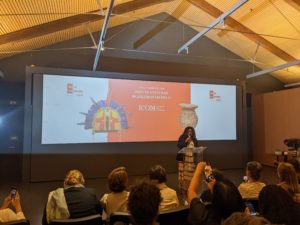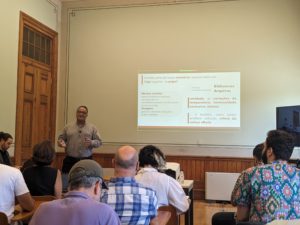Partnerships to Counter Theft and Trafficking: IFLA Joins ICOM at launch of new Red List
27 February 2023
When any type of cultural property disappears, it is a great loss to humanity. However, around the world, cultural objects are at risk of illicit theft and trafficking. This is a complex issue, and working to counter these threats is not a task that one can take on alone.
There is a need for collaboration between cultural institutions, like libraries and museums, and with law enforcement, customs organisations, and other stakeholders. IFLA is dedicated to helping protect the world’s cultural heritage, and we work with many partners to build capacity to counter the threat of trafficking.
Among these key partners is the International Council of Museums (ICOM), with whom we work closely on topics related to cultural property protection. We were delighted to join them in Sao Paolo, Brazil to celebrate the launch of an important new tool – the ICOM Red Lists of Cultural Objects at Risk for Brazil.
The ICOM Red Lists
ICOM Red Lists are practical tools to help non-experts identify objects within a specific country or region which may be especially susceptible to theft and trafficking. These are not lists of stolen items. They are examples of the cultural property that are protected under local legislation and serve to illustrate vulnerable categories of cultural objects.

Red List for Brazil
On 14 February 2023, ICOM’s National Committee for Brazil launched a Red List for Brazil. This was the result of many years of work with input from a diversity of experts. The launch was followed by a collaborative workshop which brought these many stakeholders together to discuss next steps to better protect the cultural property in their care.
The National Library of Brazil Counters Theft
The National Library of Brazil had an active role in the creation of this Red List. Mr. Alex da Silveira, from the Center for Collections and Services to Readers at the National Library of Brazil, joined the opening event to share his expertise in identifying the documentary heritage examples included in the Red List.
The National Library has been able to recover many stolen cultural objects with the help of the Brazilian Federal Police. They have implemented protection measures in areas related to collections and standards, and increased documentation of, and access to, rare materials through digitisation projects.
The National Library has also established a catalogue of missing works from their collections, which includes a search tool to explore the list by title of work, author’s name, subject and date of publication.

The National Library further cooperates with others in the field through their role on the Brazilian Advisory Council of the National Institute of Historic and Artistic Heritage (IPHAN), which monitors the movement of cultural objects.
These steps strengthen preparedness. For example, the information received through the cataloguing tool have helped enable the tracking, location, and recovery of missing pieces from their collection.
The National Library of Brazil hosts one of IFLA’s Preservation and Conservation (PAC) Centres, and we look forward to working with our partners at the library to share information on protecting library collections.
The Challenges of Protecting Documentary Heritage
ICOM invited IFLA to take part in this launch event to join an international panel of experts during this workshop, alongside partners from ICOM’s International Secretariat, UNIDROIT and Interpol. IFLA highlighted the unique challenges of documentary heritage, which must be considered by cultural institutions, law enforcement, and customs organisations to ensure these objects are protected.
IFLA noted the challenge of ObjectID, the standard used to identify movable heritage objects. This is a visually focussed identification system, which is not always applicable for books and manuscripts, whose unique identifiers may be spread across many pages. However, we touched on characteristics found in many manuscript and book traditions, such as ownership markings, as well as damage patters, that can be used as unique identifiers.
We highlighted the challenges for published materials. They are printed in multiples, intended for dissemination, and offer the opportunity for theft of individual pages. We looked at common modalities of theft in libraries and archives, including skilled and targeted theft, opportunistic theft, and internal theft.
IFLA’s expert volunteers are active in countering theft and trafficking. We took the opportunity to spotlight the work that IFLA’s Rare Books and Special Collections Section is carrying out in partnership with the International League of Antiquarian Booksellers (ILAB), as well as the work IFLA is taking part on with ICA’s Expert Group Against Theft, Tampering, and Trafficking (EGATTT). We also highlighted the work of IFLA’s PAC Centre hosted at Qatar National Library. Through their Himaya project, the PAC Centre has been deeply involved in countering the illegal sale of manuscripts in the MENA region and neighbouring countries, including innovative projects to counter sale online and on social media.
Finally, we offered actions that can be taken by different stakeholders, including professionals working in cultural institutions, by leadership in these institutions, and by other stakeholders, such as law enforcement and customs officers.
What can Library Professionals Do?
Because it is very difficult to recover object once they enter the black market, it is important to focus on preparedness. Steps like strengthening security measures, where possible, like monitoring special collection reading rooms, can be impactful. Establishing clear documentation policies is important to track the movement of materials. Regular stock checks or audits, with accompanying record keeping, are also helpful.
Libraries can work to ensure catalogues of rare materials and special collections are thorough and up to date. This should include taking good images – digitisation projects are excellent, but simple reference photographs can also work well.
This will help library professionals follow the principles of Object ID when possible, recognising that this might not fit with library cataloguing practices. Including records of ownership markings or other unique identifiers can make a big difference if material does go missing.
What can Institutional Leadership Do?
Of course, all of these actions require budget and institutional support. We encourage leaders and decisionmakers to consider preparedness a top priority. This may include assigning budget to projects which improve cataloguing, target gaps in security, and enable digitisation. Ensuring good human resource management, training, and capacity building among staff can help support these actions.
It is important that staff knows how to report stolen material, and that they feel safe to do so. Reporting policies might include enabling staff to share all information possible with local law enforcement and consider using tools like ILAB’s Missing Book Register.
We encourage you to refer to ICOM’s Red Lists, and consider documentary heritage items, both those included on the Lists and others within your own collection, which may be in danger.
These tools, and others provided by IFLA (see below) can help you engage with other stakeholders in your network who may help in the fight against theft and trafficking.
For more, please refer to the following resources:
Combatting Illicit Trafficking of Documentary Cultural Heritage: an introduction [pdf]
Theft and Trafficking of Documentary Heritage: Key considerations and challenges [Slides]
On 15 February 2023, IFLA joined partners from ICOM to celebrate the launch of the ICOM Red List for Brazil and spotlight key considerations for countering the theft and trafficking of documentary heritage.